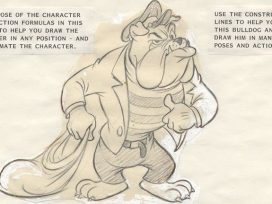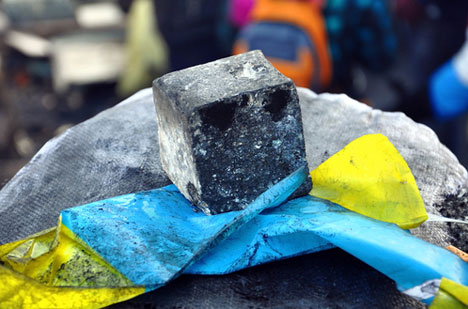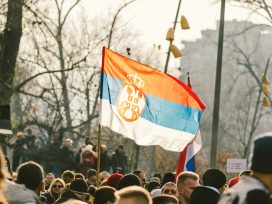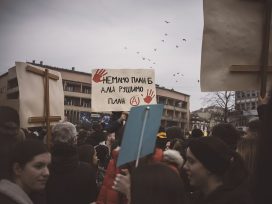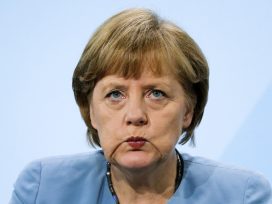It took three months for Ukrainians to overcome their fear and illusions concerning the criminal Ukrainian regime and push the world toward a reality check. Once it reached its tipping point, the world saw a large-scale rebellion carried out by the people, many of whom had never been involved in protests before, and for whom the process of ousting Yanukovych was intense enough to override social and political barriers. However, life won’t go back to normal that quickly; the ongoing occupation of Crimea and other cities in eastern Ukraine ensures that the people are kept on high alert.
On a sunny morning on 18 February, thousands of people left Maidan and went up Instytutska Street toward the Ukrainian parliament, the Rada. Instytutska had been cut off by two barricades; in fact, the upper barricade was the border between two worlds, the hub of the rebellion on Maidan and the government area, also known as the Pechersk Hills. The entrance was extremely narrow, about two meters wide, so people had to wait in line to get in.
My friends and I knew, although we didn’t say it out loud, that the idea was a bad one: unlike Maidan, with its many exits to the city, fortified and controlled by protesters, here on the government hill and the other streets further up, we were squeezed between vacant office and apartment buildings, and controlled by the riot police – the Berkut. In other words, the chances of escape were poor.
However, people went on enjoying each other’s company, the sun and the flags. First, came companies (sotnias) of Maidan paramilitary units, then Samooborona (Self-defense of Maidan), then activists. The line at the barricade applauded a guy playing the bagpipes. This was just an episode, one of thousands, demonstrating the fantastic assault on the senses that the Ukrainian revolution constituted: national and party flags, EU flags, a guy playing Beethoven’s Ode to Joy, men and women in second-hand British and German camouflage with wooden shields sporting classic quotes or slogans and “V” signs, presumably inspired by V for Vendetta.
In a few hours, at least ten people were killed. The narrow entrance in the barricade became a trap; people were beaten by titushki (paid thugs) and riot police while trying to escape. Hundreds were injured that day, and that was just the beginning of two days of bloodshed.
The beginning of the end
That night Maidan was attacked, and the police pressed forward, nearly as far as the now-famous stage. The Berkut set the Trade Union building on fire, Maidan’s headquarters since December. The death toll is still not clear; at least two burned bodies were found. The fire could not be extinguished, as the Berkut had cut off the water supply.
As it would later become clear, this was the only part of the operation that police and the SBU (the Security Service of Ukraine) were prepared to deploy. Fortunately, they did not achieve their goal of turning Maidan into a bloodbath. Either they underestimated the resistance of Maidan and Kyiv in general, or some municipal executives who were ordered to cut off the water supply and electricity, acted as saboteurs, or something else altogether prevented a full-scale tragedy; in any case, Maidan stood the next day, and the day after that. On Thursday morning, 20 February, the riot police retreated somewhat and some protesters crossed the front line. Then, snipers began shooting. That morning, most of the Nebesna Sotnia, “Heaven’s Company,” died, and that was the beginning of Yanukovych’s end.
Why did people go to parliament on Tuesday morning? Some politicians and pundits would later say that it was a great mistake to leave the safe perimeter of Maidan. Nevertheless, that day in the column it was not only Self-defence who wore protective gear, and we entertained ourselves by guessing who the people marching next to us were: “I bet this one is at least a department head,” “That, I’m sure, is a CEO,” and “I bet that one on the left is in marketing!”
This was both usual and unusual. During the clashes in mid-January, we got used to seeing people with baseball bats and crowbars in the sushi restaurants and pricey pubs on Maidan and in the nearby streets, and guys exchanging expensive clothes for protective gear next to their 100,000-dollar cars. Even on the first night, the waiters and waitresses were no longer nervous, as if it were the most normal thing on earth to see guys in masks at the table. The Ukrainian protests belonged to all classes and were a mix of multiple realities; a combination of nineteenth-century national revolution and an Occupy protest, a rebellion of repressed businessmen, an anarchist commune and a warrior camp. Maidan became home to both Cossacks in traditional costumes and an IT tent (the head of the Ukrainian office of Microsoft took a vacation to stay on Maidan), a place for medieval weapons such as a catapult and a ram, and almost non-stop online broadcasting, tweeting and streaming. The first catapult on Hrushevsky Street, the location of the January clashes, was constructed from diagrams found on the Internet and uploaded to a smartphone right next to the front line. The frame holding the screen that activists installed in front of the police cordon to ruin the information blockade by providing TV-news was made by joiners from the Carpathians. Maidan was an area in which all could work and fight together, hipsters and farmers, anarchists and bankers, the poor and the wealthy. The first serious clashes in mid-January happened when football fans and ultras joined the protest. The fans of competitive football clubs concluded an armistice during the revolutionary period. Ukraine might be the only country in Europe in which people praised ultras for defending them from the police.
From “Student Maidan” to AutoMaidan
However, this didn’t all happen from the beginning. During the first days of November, Maidan was relatively small, just a few thousand Kyiv professionals and students, mobilized mainly by a Facebook post, most of whom knew each other from previous demonstrations and actions; four years of Yanukovych leading the cabinet with unprecedented corruption and injustice had not been easy. Before the brutal beating on 30 November, students from other cities came (which may explain why this first Maidan was called “Student Maidan”), and the night of the beating became part of Ukrainian collective memory, like a sort of Childermas.
The morning straight after that night, and the next day, Maidan changed: people who had never been politically active before, came to Maidan. It was not about signing the agreement with the EU, it was about being against the regime and its brutality.
Many new initiatives started at the beginning of the new big Maidan, such as AutoMaidan, mostly represented by Kyiv’s middle class business community and professionals. While Samooborona remained mostly within the Maidan perimeter to defend the barricades, AutoMaidan worked throughout the city and beyond, providing Maidan with firewood, food and other essentials, patrolling the streets and protesting near luxury estates belonging to Yanukovych and other authorities in the Kyiv suburbs. AutoMaidan’s race to Mezhyhirya, Yanukovych’s residence, was precisely recorded by the police, every vehicle registered and recorded on a list. Many cars from that list would be burned; the owners of others lost their driver’s licenses in kangaroo courts, in which no effort was made to pretend that the cases were legitimate. This happened to one of the leaders of AutoMaidan, who called for a strike near the Rada on 19 January; he had to flee quickly. Another leader, Dmytro Bulatov, was kidnapped and tortured. Earlier, Ihor Lutsenko, the deputy commandant of Maidan and a well-known activist, was also kidnapped and tortured, and was surprisingly asked the same question: who was providing financial support for AutoMaidan? This is symptomatic: the criminals, obviously affiliated with the police and the regime, had no idea what the Ukrainian middle-class was or how audacious and capable it was in those days.
AutoMaidan is important in terms of the social structure of the revolution and proof that it was not a western Ukrainian project. During the Orange Revolution in 2004, people from all regions took part and Kyiv held up the rear. This time, Kyiv’s young bourgeoisie were the active participants and the vanguard. They not only had cars (and were prepared to forfeit them) and enough money to spend on petrol, but knew the city very well. Local patriotism also mattered: after Yanukovych came to power, all cabinets and positions that mattered, especially in security, were occupied by people from the Donetsk and Luhansk regions, the most loyal to Yanukovych. In Kyiv and other cities, this was perceived as occupation, and urban folklore, far from politically correct, compared “Donetsky” with the Nazi occupation during the Second World War. When titushki began to come to Kyiv, the courage with which people secured the streets was probably a reflection of the last four years of bitterness at living under occupation.
Maidan erupts
Back to the morning of 18 February: people remained on the Pechersk Hills even after the first minor clashes turned into serious fighting, even after snipers began to shoot from the rooftops. Police threw stun grenades into the crowd. The crossroads of Instytutska and Shovkovychna, one of the streets leading to the parliament, at the time blocked by trucks and a police cordon, is in fact narrow, making it much harder to maneuver than during previous clashes on Hrushevsky Street and Evropeyska Square. But people stood their ground. From time to time they helped paramedics to take away some of the injured and shell-shocked – and they stood their ground.
This is what Yanukovych and his allies could not understand. They themselves fell victim to their own propaganda and self-isolation; they missed the point of no return, the point at which people were not afraid any more. First, it was just that the harder the regime pushed, the harder the response was. When Maidan was attacked in December 2013, thousands came in the middle of the night. Those who could not take a taxi or carpool with friends and acquaintances came on foot. However, after the 16 January “dictatorship laws”, everything changed profoundly: it was no longer a non-violent protest. According to the “dictatorship laws”, pushed through parliament via a breach of procedure and thus the law, all forms of protest Maidan had used previously were prohibited. For instance, the provision of up to fifteen days in jail for wearing a mask, a helmet, or “other means of concealing or protecting the face or the head” was met by large-scale protest in just two days: people put kitchens utensils – pots, basins, and colanders – on their heads; and, of course, helmets. As one of the dictatorship laws obliged NGOs that accept financial support from foreign institutions to register as “foreign agents” and to pay additional taxes, all of the social networks were full of statements such as: “I am a foreign agent!” People chose to break the absurd laws deliberately instead of hiding at home, waiting for further repression.
If you can be arrested for wearing a hard hat or writing a Facebook post, why shouldn’t you throw a Molotov cocktail or a cobblestone? As the risk of large-scale repressions became real, Maidan erupted.
After a few weeks of violent clashes that saw four activists shot, hundreds injured, and dozens arrested, the terror of thugs under police cover, kidnapping and torture, the opposition leaders didn’t have anything to show for their negotiations with Yanukovych, other than that most of the “dictatorship laws” were revoked and most activists discharged (although not absolved). Instead, Yanukovych demanded that the buildings on Maidan and Khreshchatyk be abandoned. In fact, Yanukovych acted just like a terrorist: creating threats, taking hostages and then making demands. All this meant that the protesters had to withdraw to a position that was even weaker than before 16 January.
On Tuesday morning, people went to parliament not only in protest against the regime; they also came for the opposition. They came to support those few MPs they trusted, and to put pressure on those who were not firm enough. They came not just to protest, but also to block parliament if it would not vote to revert to the previous version of the constitution, the one that stipulated reduced presidential powers. As the Rada speaker refused to put it on the agenda, the tires in front of the police cordon on Hrushevsky Street were again set on fire. The black smoke was a signal to the MPs inside parliament: “We are here and we will not accept a compromise.”
Then came a day of massacre, and a night when Maidan was almost taken over, with the streets full of thugs; and the morning, with the Trade Union building still glowing, and Maidan still under attack. The metro was closed for the first time since its construction. But Khreshchatyk was full of people, thousands again. Almost everyone had at least one package with food and hot drinks. Many seemed to be there for the first time, not just for a Sunday meeting, but for a serious matter.
Those who didn’t come to feed the mostly homeless Maidan residents came to make Molotovs and to pull up the cobblestones. Many people came from other cities despite numerous roadblocks. This was the people of Kyiv taking their beloved city apart to protect it.
On one of the plinths of the granite façade was a cobblestone, just at arm’s length. A guy in a black mask, armed with a stick, used it to secure a new garbage bag: Maidan needed more rubbish bins.
Shura’s story
That Tuesday night, Shura Ryazanceva, an AutoMaidan activist, dragged out an injured protestor on Instytutska. She had been just about to leave the country the next morning, but decided to come to the city and join the paramedics. When she tried to pull the injured man from the firing line, someone picked him up and covered them both with his shield. They chatted on their way back to the firing line from hospital; the next morning he was dead: shot by a sniper on Instytutska.
Shura is from Yalta, Crimea. Her father was a military pilot and she was brought up in a military family ethos. Shura graduated from the National Academy for Internal Affairs and worked briefly as a crime investigator for the police. “Here I do almost the same as I once did as an investigator”, she says.
After what happened during the last days of the Yanukovych regime, Shura got a tattoo on her hand: “Nebesna Sotnia. 18.02.-20.02.” This tattoo made the Berkut furious; the same Berkut who ran away from Kyiv after Maidan had won and who she would meet again at the checkpoint in Crimea a few weeks later, after the Russian invasion. Shura and four other activists and journalists were kidnapped and detained at the Russian naval base. Previously, they had been beaten, forced to kneel, and their hands tied. The Berkut cut Shura’s hair and threated to cut her tattooed arm. “The interrogators at the naval base thought we were spies; they were fairly rational, but still naïve, and kept asking the hostages who was financing them; the same questions were asked of the other kidnapped activists – Ihor Lutsenko and Dmytro Bulatov.”
Meanwhile, many people in the city of three million panicked, buying out groceries and fuel, and emptying the ATMs. This was actually the first time the panic had become serious. During the winter, any trace of revolution was barely visible, even just one metro stop from Maidan.
Later that day, when someone announced several times that a grenade needed to be dismantled just a few meters away, those on Maidan didn’t even bother – something had changed profoundly. Although the crowd at Maidan had earlier demonstrated that it was in fact a revolution of rational people – if people started to run in fear and cause panic, others stopped them quickly – Maidan’s behavior on Thursday was different.
“Everything has changed,” said Shura, preparing messages of support for Ukrainian soldiers in Crimea in the AutoMaidan headquarters. With her many tattoos, she looks more like a rock-star; before Maidan she had been working as a stylist for the most popular comedy show on Ukrainian TV. “My old job seems so irrelevant after everything that has happened.”
When the dead bodies were brought from Instytutska to Maidan on Thursday morning, few people cried. In the new reality of the destroyed Maidan, it was full of Molotovs, the Trade Union building still burned, the Central Post office and some shops had been turned into hospitals, ten dead bodies lay bleeding in front of the Kozatsky Hotel, McDonald’s, and the tram stop. In a tent that had been a café just a few days earlier and had recently been turned into an aid post, some other injured people lay dying. A woman was crying and telling everyone that there was a sniper on the roof of Kozatsky. No one took her seriously. The people on stage prevented everyone from staying within the perimeter of Maidan. Snipers were presumably shooting from the roof of the highest point above Maidan – the Stalinist-style building of the Ukraine Hotel. Minor clashes with titushki had been reported from the other sides of Maidan. For a few hours, it seemed safer on Maidan than away from it.
The revolution continues
AutoMaidan’s first visit to Yanukovych’s estate in December 2013 was a challenge, and provoked the subsequent acts of repression against the activists. The second time they went to Mezhyhirya was after Yanukovych had fled, to provide security for the tourist attraction. Thousands came along on that Saturday morning, 22 February, not only journalists and activists, but also families with children. Perhaps some of these visitors had not taken an active part at Maidan; nevertheless, it was important for them to see the den of the tyrant, empty.
“Look, we really ruined Putin’s morning”, I said to my friend. “Can you imagine, the whole world sees us walking around the most protected estate in this country, and the whole world understands that other dictators might be next.”
A couple of hours later we left Mezhyhirya, still wearing our already useless flak jackets. We paused in front of the TV screen at the petrol station in Gostomel, as did the staff of the fast food café and the cashier. The Ukrainian Parliament had just voted to reject Yanukovych. We all sang the national anthem along with the TV, just standing there, at the petrol station.
The revolution may not have been over, but we really did ruin Putin’s morning. The following day, turmoil began in Sevastopol, and within four days Russian forces had seized the government buildings in Crimea.
With the continued violation of Crimea and the wounds of the events on Maidan still fresh in the minds of Ukrainian people, how will the developing conflict with Russia be played out over the next few months?
